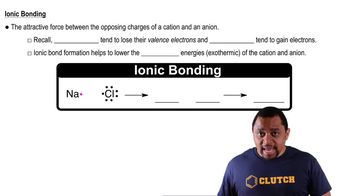Here are the essential concepts you must grasp in order to answer the question correctly.
Ionic Bonding
Ionic bonding occurs when electrons are transferred from one atom to another, resulting in the formation of charged ions. The electrostatic attraction between these oppositely charged ions creates a strong bond. The strength of ionic bonds is influenced by the charges of the ions and the distance between them, which is critical for understanding bond enthalpy.
Recommended video:
Bond Enthalpy
Bond enthalpy, or bond dissociation energy, is the amount of energy required to break a bond in a molecule in the gas phase. It is a measure of bond strength; higher bond enthalpies indicate stronger bonds. In ionic compounds, bond enthalpy can vary significantly based on the size and charge of the ions involved, affecting the stability of the ionic bond.
Recommended video:
Trends in Ionic Radii
Ionic radii refer to the size of ions in a crystal lattice. As you move down a group in the periodic table, ionic radii increase due to the addition of electron shells. This increase in size affects bond length and bond enthalpy; larger ions typically form longer and weaker bonds, which is essential for predicting the bond enthalpy of Li—F versus Cs—F.
Recommended video:
 Verified step by step guidance
Verified step by step guidance

